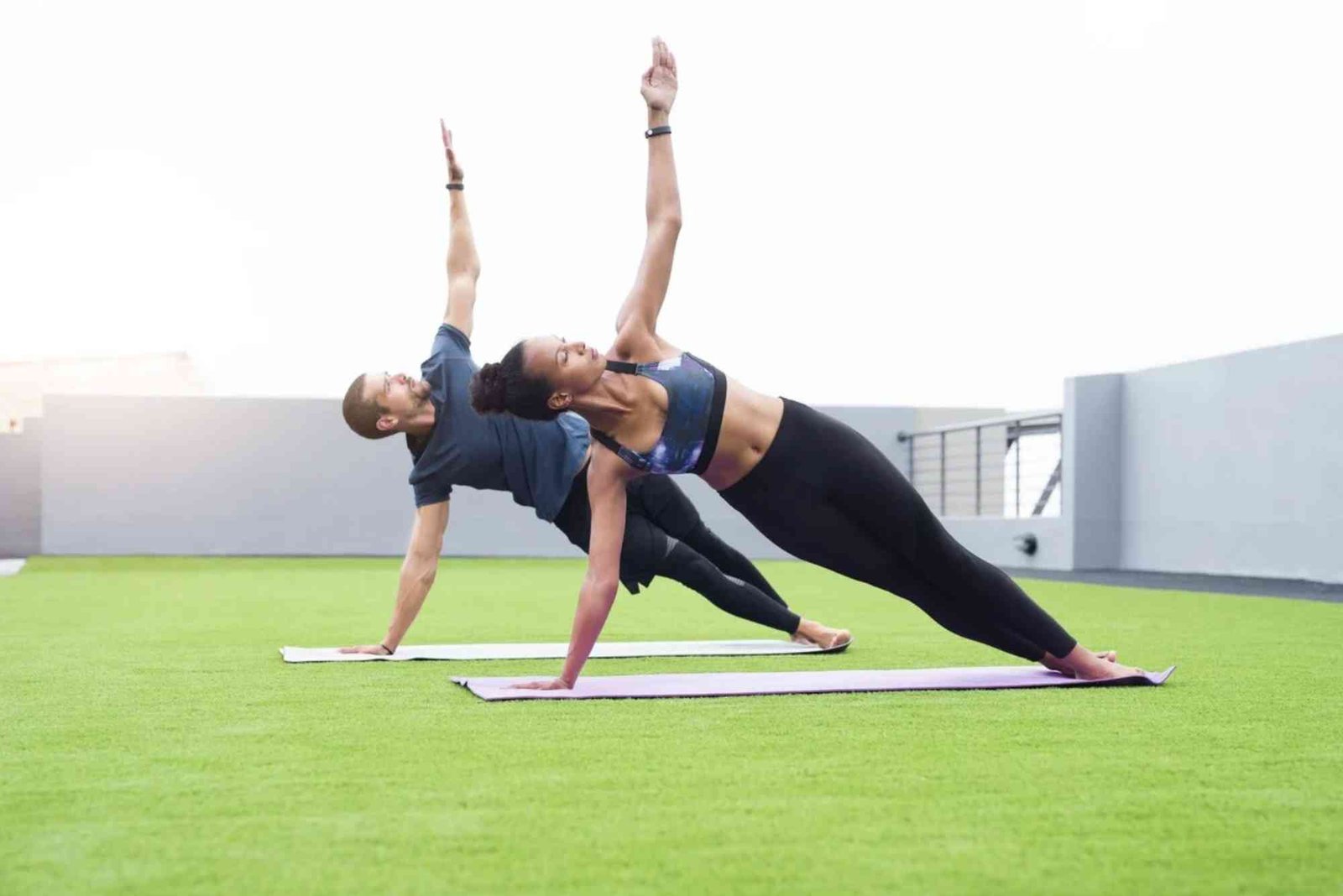Introduction
Yoga and meditation are ancient practices that have stood the test of time, offering profound physical, mental, and emotional benefits. In today’s fast-paced world, stress, anxiety, and fatigue have become part of daily life. Yet, through consistent practice of yoga and meditation, individuals can restore balance, enhance mental clarity, and build a deeper connection between mind and body.
Understanding the Connection Between Yoga and Meditation
Yoga and meditation are often practiced together because they complement each other. Yoga focuses on movement, strength, flexibility, and balance, while meditation enhances mental calmness and mindfulness. Together, they form a holistic approach to well-being. Yoga prepares the body for meditation by releasing tension, improving posture, and increasing blood flow. Meditation, in turn, deepens self-awareness and cultivates inner peace.
The Physical Benefits of Yoga
Practicing yoga regularly transforms the body from within. It enhances flexibility, builds strength, and improves posture. When performed consistently, yoga can also alleviate chronic pain and boost overall energy.
Improved Flexibility and Strength
One of the most noticeable Benefits Of Yoga is increased flexibility. Simple poses such as downward dog, triangle pose, and forward bends gently stretch the muscles, joints, and ligaments. Over time, stiffness and soreness are reduced. Strength also develops naturally as you hold poses that engage the core, arms, and legs.
Better Posture and Balance
In a world where many spend hours at desks or looking at screens, poor posture has become a major concern. Yoga helps realign the spine, strengthens the back muscles, and encourages awareness of body alignment. Balance poses like tree pose and warrior III improve stability and coordination, reducing the risk of falls and injuries.
Enhanced Circulation and Heart Health
Yoga improves blood flow, oxygenation, and overall cardiovascular health. The deep breathing practiced during yoga (known as pranayama) increases lung capacity and enhances oxygen supply throughout the body. Studies suggest that regular yoga practice may help lower blood pressure and cholesterol levels.
Boosted Immunity and Energy Levels
Through better circulation and stress reduction, yoga supports the immune system. It also promotes the release of endorphins, the body’s natural mood boosters, leaving you feeling energetic and rejuvenated after every session.
The Mental and Emotional Benefits of Meditation
Meditation strengthens the mind just as yoga strengthens the body. It trains attention, reduces stress, and fosters emotional stability. In a world filled with distractions, meditation offers a sanctuary of stillness and focus.
Stress Reduction and Emotional Balance
One of the primary Benefits Of Yoga And Meditation is the reduction of stress and anxiety. Mindfulness meditation helps calm racing thoughts and brings awareness to the present moment. Scientific research has shown that regular meditation lowers cortisol levels, the hormone responsible for stress, promoting a sense of peace and emotional control.
Improved Concentration and Mental Clarity
Meditation enhances the ability to focus. As the mind learns to remain still and attentive, productivity increases, and decision-making becomes easier. Many professionals and students use meditation to improve performance and creativity.
Better Sleep Quality
For those struggling with insomnia or poor sleep, meditation can be life-changing. Relaxation techniques, such as guided meditation or breathing exercises, quiet the nervous system and prepare the body for deep rest. Practicing meditation before bedtime can help you fall asleep faster and wake up refreshed.
Enhanced Self-Awareness and Mindfulness
Meditation fosters self-reflection and personal growth. It helps individuals understand their thoughts, emotions, and behaviors more clearly. As awareness deepens, so does compassion for oneself and others, improving relationships and emotional intelligence.
Combining Yoga and Meditation for Maximum Benefits
When yoga and meditation are practiced together, the results are even more powerful. Yoga readies the body by removing physical blockages, while meditation clears the mind. The combination promotes harmony, making it easier to achieve balance in every aspect of life.
A short yoga session followed by 10–15 minutes of meditation can help you start or end your day with clarity and calmness. Whether you’re a beginner or an experienced practitioner, integrating both into your daily routine leads to long-term wellness and inner stability.
Practical Tips to Get Started
Start Small and Stay Consistent
Begin with short sessions—10 to 20 minutes of yoga and 5 minutes of meditation. Gradually increase duration as your comfort level improves. Consistency matters more than intensity; daily practice brings lasting results.
Create a Peaceful Space
Designate a quiet area in your home for yoga and meditation. Use soft lighting, calming scents, and a comfortable mat or cushion. The environment influences your mindset, making it easier to relax and focus.
Focus on Breathing
Breath control (pranayama) is the foundation of both yoga and meditation. Pay attention to each inhale and exhale. Deep, steady breathing calms the nervous system and enhances concentration.
Use Guided Sessions
Beginners can benefit from guided yoga or meditation videos. These provide structure and expert instructions, helping you maintain proper posture and focus. You can explore resources and Read more on www.yogajournal.com for professional guidance and inspiration.
Be Patient and Kind to Yourself
Progress in yoga and meditation is gradual. Avoid comparing yourself to others or expecting perfection. The journey is about self-discovery, not competition.
Expert Advice for Deepening Your Practice
Certified yoga instructors and meditation teachers often emphasize mindfulness and intention. Here are some expert suggestions:
-
Practice early in the morning for maximum freshness and focus.
-
Use affirmations during meditation to cultivate positivity.
-
Mix different yoga styles such as Hatha, Vinyasa, or Yin to keep practice engaging.
-
Attend workshops or retreats to learn advanced techniques.
-
Listen to your body; rest when needed.
These professional insights ensure that your routine remains safe, effective, and personally rewarding.
Common Challenges and How to Overcome Them
Even dedicated practitioners face challenges like restlessness, distraction, or physical discomfort. To overcome these:
-
Start with simple poses and short meditations.
-
Use breathing to refocus the mind when distracted.
-
Avoid practicing on a full stomach.
-
Stay consistent even on busy days—five minutes is better than none.
With time, the body and mind adjust, and the practice becomes a source of joy and strength.
The Science Behind Yoga and Meditation
Modern research supports what ancient wisdom has long taught. Numerous studies show that yoga and meditation improve heart rate variability, reduce anxiety, enhance cognitive function, and slow the aging process. Regular practice can even alter brain structure, increasing gray matter in areas related to emotional regulation and memory.
Doctors now recommend yoga and meditation as complementary therapies for conditions such as depression, hypertension, chronic pain, and insomnia. These findings affirm the holistic power of these timeless disciplines.
The Benefits of Yoga and Meditation extend beyond fitness—they touch every part of human existence. By incorporating mindful movement and meditation into your daily life, you can achieve better physical health, emotional stability, and spiritual awareness. Whether you’re seeking relaxation, strength, or self-discovery, this practice offers the path.
Frequently Asked Questions
What are the main benefits of yoga and meditation?
Yoga and meditation improve physical flexibility, strength, and posture while reducing stress, anxiety, and fatigue. Together, they promote overall well-being and inner peace.
Can beginners practice yoga for results?
Even 5 to 10 minutes of daily meditation can make a difference. Consistency matters more than duration.
When is the best time to practice yoga and meditation?
Morning practice helps energize the body and focus the mind for the day, while evening sessions promote relaxation and better sleep.
Do yoga and meditation help with mental health?
Absolutely. Both practices reduce cortisol levels, improve mood, and enhance emotional resilience, supporting long-term mental health.















